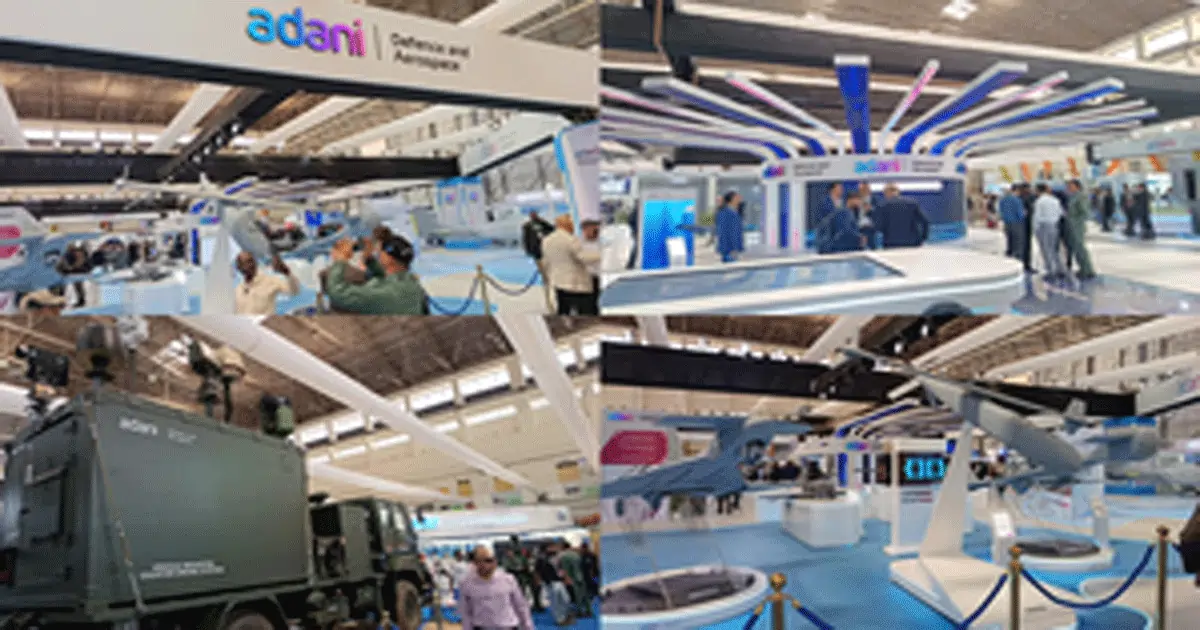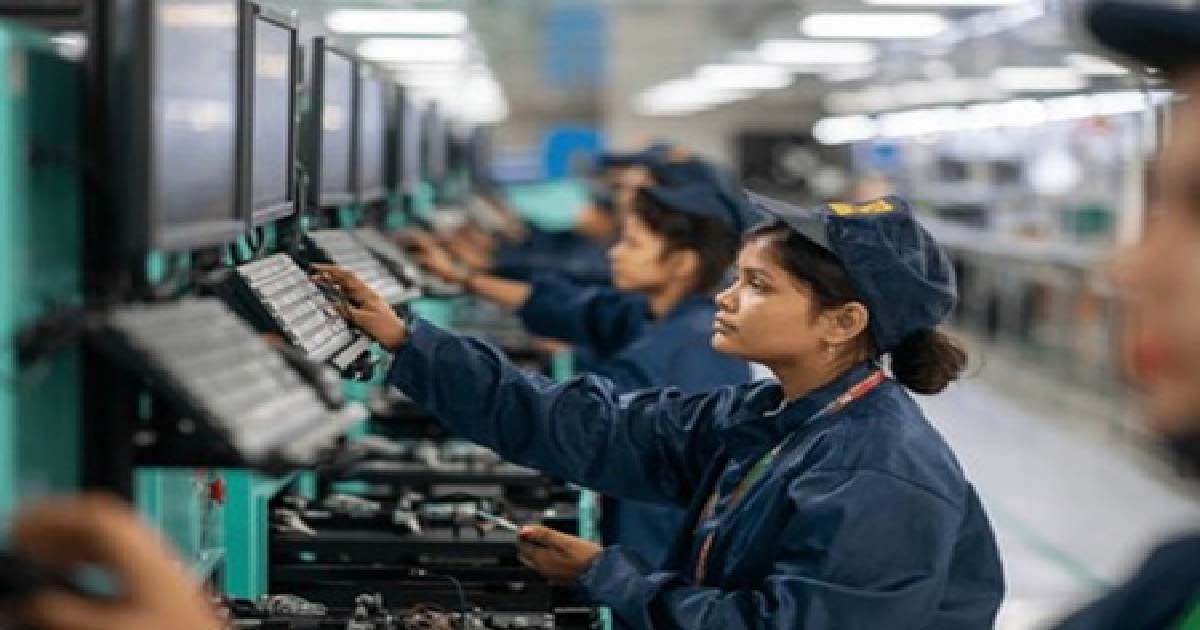Business
Aero India 2025: Futuristic warfare tech takes centre stage at Adani’s Defence & Aerospace stall

Bengaluru, Feb 12: The Adani Defence and Aerospace stall, showcasing futuristic technology, has been one of the main attractions at Asia’s largest five-day air show and the 15th edition of the country’s premier aerospace exhibition ‘Aero India 2025’ in Bengaluru.
Focusing on cutting-edge technology, the spacious stall features state-of-the-art weaponry. The highlight of the display is the ‘Vehicle-Mounted Counter-Drone System’, developed in collaboration with the Defence Research and Development Organisation (DRDO).
The stall presents futuristic weaponry across four layers of defence, covering protection, detection, neutralization, and the use of artificial intelligence in safeguarding national borders.
Speaking to media, Ashish Raghuvanshi, CEO of Adani Defence and Aerospace, stated, “All the capabilities we are working on are on display at the show. From drones to small arms, ammunition, missiles, surface-guided missiles, and most importantly, artificial intelligence and advanced machinery, Adani has been working closely with the defence sector.”
Ashok Wadhwan, Head of Land Systems, said, “We aim to become strategic partners of the defence forces. Our focus is on futuristic technology, developing products that go beyond their expectations. If they can imagine a capability, we want to turn it into reality and build those advanced systems in India.”
Providing details about the display, Wadhwan elaborated, “We have structured our technology into four layers. The first layer focuses on protection, which includes unmanned vehicles and unmanned underwater systems designed for initial surveillance and threat detection.”
He continued, “The second layer is detection, which includes aircraft converted into aerial surveillance platforms — our ‘eyes in the sky’. We are focusing on detection across land, air, and underwater domains. The third layer is neutralization, which includes loitering objects, missiles, and other ammunition. The final layer comprises advanced weaponry, including firearms.”
“In addition, we are showcasing artificial intelligence-powered solutions designed to protect forces. Our capabilities are built to detect, neutralize, and safeguard borders,” he said.
“Our primary focus is on the Indian Army, Navy, and Air Force, though exports are also part of our strategy. However, our priority remains our national defence forces,” Wadhwan underlined.
“We are collaborating with Defence Public Sector Units (DPSUs) rather than competing with them. Our aim is to partner with them to enhance national defence capabilities,” he added.
Discussing the partnership with DRDO, he explained, “We work closely with DRDO as a Development cum Production Partner (DcPP) for missiles and counter-drone systems. We have localized these technologies and successfully delivered them to the armed forces.”
Highlighting the significance of the Vehicle-Mounted Counter-Drone System, Ashish Raghuvanshi, CEO of Adani Defence and Aerospace stated, “Electronic warfare is a crucial aspect of future air defence. Drones pose significant threats to both civil and military establishments. The system displayed here can detect drones of all sizes and offers users multiple options for neutralization.”
“Operators can choose between a soft-kill jammer or a hard-kill laser. This innovation is a major advancement for the country, developed under a public-private partnership. We will continue to innovate and improve these solutions,” he added.
Emphasizing the importance of detection in electronic warfare, Raghuvanshi noted, “Detection is a critical component of electronic warfare. Our modular and effective solution can distinguish between a friend and a foe, enhancing operational security.”
On the benefits of partnering with DRDO, he said, “For example, DRDO’s Centre of Excellence for missiles is among the best in the world. Strengthening public-private partnerships will help elevate these technologies to the next level, ensuring India remains at the forefront of defence innovation.”
Business
India 2nd largest mobile manufacturing country in the world: Minister

New Delhi, Dec 27: India has ramped up electronics production six-fold and is the second largest mobile manufacturing country in the world, Union Minister of Electronics and Information Technology Ashwini Vaishnaw said on Saturday.
In multiple posts on social media platform X, Vaishnaw said that the country has increased electronic exports eightfold over the past 11 years, mainly driven by policy support from the Production Linked Incentive Scheme.
The PLI scheme for Large Scale Electronics Manufacturing has attracted over Rs 13,475 crore in investment and helped achieve production of about Rs 9.8 lakh crore in the electronics sector, driving manufacturing, jobs, and exports, he said.
Vaishnaw highlighted that “over 1.3 lakh jobs were created in the last five years and that electronics is now India’s third‑largest export category, climbing from seventh place”.
He said the country was initially focusing on finished products, but the Electronics Component Manufacturing Scheme supported a shift to “building capacity for modules, components, sub-modules, raw materials, and the machines that make them.”
The Electronics Component Manufacturing Scheme has 249 applications representing Rs 1.15 lakh crore in investment, Rs 10.34 lakh crore in production, and creating 1.42 lakh jobs, the post said, adding it is the highest-ever investment commitment in India’s electronics sector, indicating industry confidence.
Vaishnaw also noted progress in the semiconductor sector, saying ten units have been approved, with three already in pilot or early production. The minister said that “fabs and ATMPs from India will soon supply chips to phone and electronics manufacturers”.
“Electronics manufacturing created 25 lakh jobs in the last decade. This is the real economic growth at the grassroots level,” the minister said.
“As we scale semiconductors and component manufacturing, job creation will accelerate. From finished products to components, production is growing. Exports are rising. Global players are confident. Indian companies are competitive. Jobs are being created. This is ‘Make in India’ impact story!” he noted.
Business
Indian stock market ends holiday-shortened week in positive terrain

Mumbai, Dec 27: Indian equity markets ended the week in a positive terrain, buoyed by expectations of stronger domestic demand, a favourable liquidity outlook and optimism over potential Fed policy easing in 2026, analysts said on Saturday.
The holiday-shortened week opened with a bullish undertone; however, momentum tapered off as the days progressed.
On Friday, Sensex closed at 85,041.45, slipping 367.25 points or 0.43 per cent. Nifty also ended in the red, falling 99.80 points or 0.38 per cent to settle at 26,042.30.
According to market watchers, the year-end lull kept trading largely range-bound, with hopes for a Santa Claus rally diminishing amid the absence of fresh catalysts, limited progress in US–India trade talks, and caution ahead of the upcoming earnings season.
“Sectoral trends were mixed, marked by selective profit booking across most segments, while metals, FMCG, and media stocks offered notable resilience,” said Vinod Nair, Head of Research, Geojit Investments Ltd.
Nifty 50 ended the week at 26,042, continuing to respect its long-term rising channel on the daily chart. The index remains comfortably above the 20-day EMA cluster, preserving the medium-term bullish structure, said analysts, adding that as long as Nifty sustains above the 26,000–25,900 support zone, the overall bias remains positive.
On the domestic front, RBI’s liquidity interventions, such as open market operations and a USD/INR buy–sell swap, helped stabilise the rupee, though persistent FII outflows continued to weigh on sentiment.
Meanwhile, gold advanced on safe-haven demand, while crude prices hovered near multi-year lows, though U.S. steps to tighten pressure on Venezuelan oil shipments could exert upward pressure in the near term
Looking ahead, market sentiment is likely to stay cautious as investors brace for the upcoming earnings season while remaining attuned to global developments and currency movements, said analysts.
Attention will also turn to next week’s data releases, including India’s industrial and manufacturing output figures, manufacturing PMI, and the US FOMC minutes, said Nair.
Business
Keralites gulped liquor worth over Rs 332 crore during Christmas

Thiruvananthapuram, Dec 26: The Kerala State Beverages Corporation (BEVCO) recorded a sharp surge in liquor sales during the Christmas week, with revenues touching a record Rs 332.62 crore, according to official figures.
The Christmas week sales are calculated for the four days from December 22 to December 25, and officials said this year witnessed a significant jump compared to previous years.
Data shows a 19 per cent increase in sales over the corresponding period last year, underlining a strong festive demand.
The sharpest spike was recorded on Christmas Eve, when liquor sales alone amounted to Rs 114.45 crore.
In comparison, sales on the same day last year stood at Rs 98.98 crore, indicating a substantial year-on-year rise.
Officials attributed the surge not only to the festive season but also to improved consumer facilities introduced by BEVCO over the past year.
The corporation had expanded its premium retail infrastructure, including the launch of new premium counters aimed at offering a better purchasing experience and a wider selection of high-end products.
Premium outlets were recently opened in key centres such as Thrissur and Kozhikode, and officials said these had a positive impact on overall sales figures.
The enhanced facilities helped reduce crowding at regular outlets and encouraged higher-value purchases, contributing to the increase in revenue.
The Corporation has traditionally seen a spike in sales during festival periods such as Onam and Christmas, but this year’s figures mark one of the highest Christmas week turnovers recorded by the state-run corporation.
The rise in liquor sales is expected to provide a significant boost to the State exchequer, as the corporation is a major contributor to Kerala’s revenue through taxes and duties.
Liquor is sold through state-run 325 retail outlets.
Studies have shown that around 10 per cent of the 3.30 crore Kerala population are tipplers, including around three lakh women.
In 2024–25, Kerala’s liquor sales rose to Rs 19,730.66 crore, up from Rs 19,069.27 crore in 2023–24, marking an annual growth of 3.5 per cent.
-

 Crime3 years ago
Crime3 years agoClass 10 student jumps to death in Jaipur
-

 Maharashtra1 year ago
Maharashtra1 year agoMumbai Local Train Update: Central Railway’s New Timetable Comes Into Effect; Check Full List Of Revised Timings & Stations
-

 Maharashtra1 year ago
Maharashtra1 year agoMumbai To Go Toll-Free Tonight! Maharashtra Govt Announces Complete Toll Waiver For Light Motor Vehicles At All 5 Entry Points Of City
-

 Maharashtra1 year ago
Maharashtra1 year agoFalse photo of Imtiaz Jaleel’s rally, exposing the fooling conspiracy
-

 National News1 year ago
National News1 year agoMinistry of Railways rolls out Special Drive 4.0 with focus on digitisation, cleanliness, inclusiveness and grievance redressal
-

 Maharashtra1 year ago
Maharashtra1 year agoMaharashtra Elections 2024: Mumbai Metro & BEST Services Extended Till Midnight On Voting Day
-

 National News1 year ago
National News1 year agoJ&K: 4 Jawans Killed, 28 Injured After Bus Carrying BSF Personnel For Poll Duty Falls Into Gorge In Budgam; Terrifying Visuals Surface
-

 Crime1 year ago
Crime1 year agoBaba Siddique Murder: Mumbai Police Unable To Get Lawrence Bishnoi Custody Due To Home Ministry Order, Says Report












